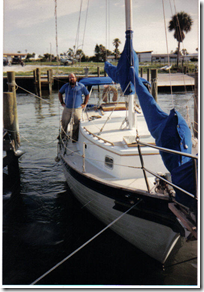#16,976
September is National Preparedness month, and while preparedness should be a year-round goal, we devote one month a year to promote it. As I do every year, I'll post new and/or updated preparedness essays on AFD throughout the month.
As a former paramedic, a cruising and live-aboard sailor for 15 years (see photo below), and someone who spent a decade going `back to the land' in the backwoods of Missouri, the fact that I'm still around after 68 knockabout years is a testament to the value of preparedness.
More than once having a well-stocked first aid kit, emergency back-up systems in place, a full pantry, or an emergency plan has served me well in an emergency. When I sailed, I carried an life raft/dinghy - aptly named `Plan B' - which was mostly used for rowing ashore to buy beer, but it was also there in case `plan A' was no longer a viable option.
For more than 50 years I've carried a first aid kit in my car ( and in my boat, and home), and while I haven't needed it often, when I have needed it, I've really, really, needed it.
We're not talking survivalism, since I'm not preparing to survive an asteroid strike, a Yellowstone eruption, WWIII or the zombie apocalypse.
But if the power (and water) goes out for a few days, or store shelves are emptied (as happens with every hurricane threat) for a week or more, I'm in pretty good shape.
For the vast majority of us who embrace the preparedness lifestyle - it is the far more common localized disaster that spurs us on:
The goal of #NatlPrep is to foster a culture of national preparedness, and to encourage everyone to plan and be prepared to deal with an event where they can go at least 72 hours without electricity, running water, local services, or access to a supermarket.. .. hurricanes, tornadoes, ice storms, blizzards, earthquakes, floods (and yes, even a pandemic) . . . along with even more limited emergencies like house fires, car accidents, or personal accident and injury.
These are, of course, minimum goals.Disruptions that follow hurricanes, tornado outbreaks, floods, and other natural disasters can potentially last for days or even weeks, and so – if you are able to do so - being prepared for 10 days to 2 weeks makes a good deal of sense (see When 72 Hours Isn’t Enough).
But for my money, the most important prep is having – and being – a `disaster buddy’.In NPM14: In an Emergency, Who Are You Going To Call?, I wrote that a `Disaster Buddy’ is simply someone you have prearranged that you can call on during a crisis, and who in turn, can call on you if they need help. And the more `disaster buddies’ you have in your personal network, the more options you will have in an emergency.
Over the next month I'll be devoting considerable blog time and space to the topic of disaster preparedness. Along the way we'll look at some threats you and your family may not have considered.I hope you’ll take some time during the coming weeks to think about how to make your family, business, or community better prepared to deal with the next disaster, and then act on it.
And that you’ll encourage others to do the same.

